Employee Absenteeism: Impact on Absence Management in Healthcares
VerifiedAdded on 2023/06/15
|26
|6077
|301
Report
AI Summary
This report investigates the impact of employee absenteeism on absence management within the healthcare sector, utilizing data from 2001 to 2017 to analyze trends and potential causes. Statistical analysis, including descriptive statistics, trend analysis, correlation, and regression, is employed to compare actual and total absenteeism rates among employees, with a focus on gender differences. The study addresses research questions related to the relationship between observed and predicted absenteeism data, differences in male and female absenteeism proportions, and underlying reasons for absenteeism. The findings provide insights for healthcare managers to develop strategies to mitigate absenteeism, improve employee attendance, and ultimately enhance patient care. The report concludes with limitations and recommendations for future research.
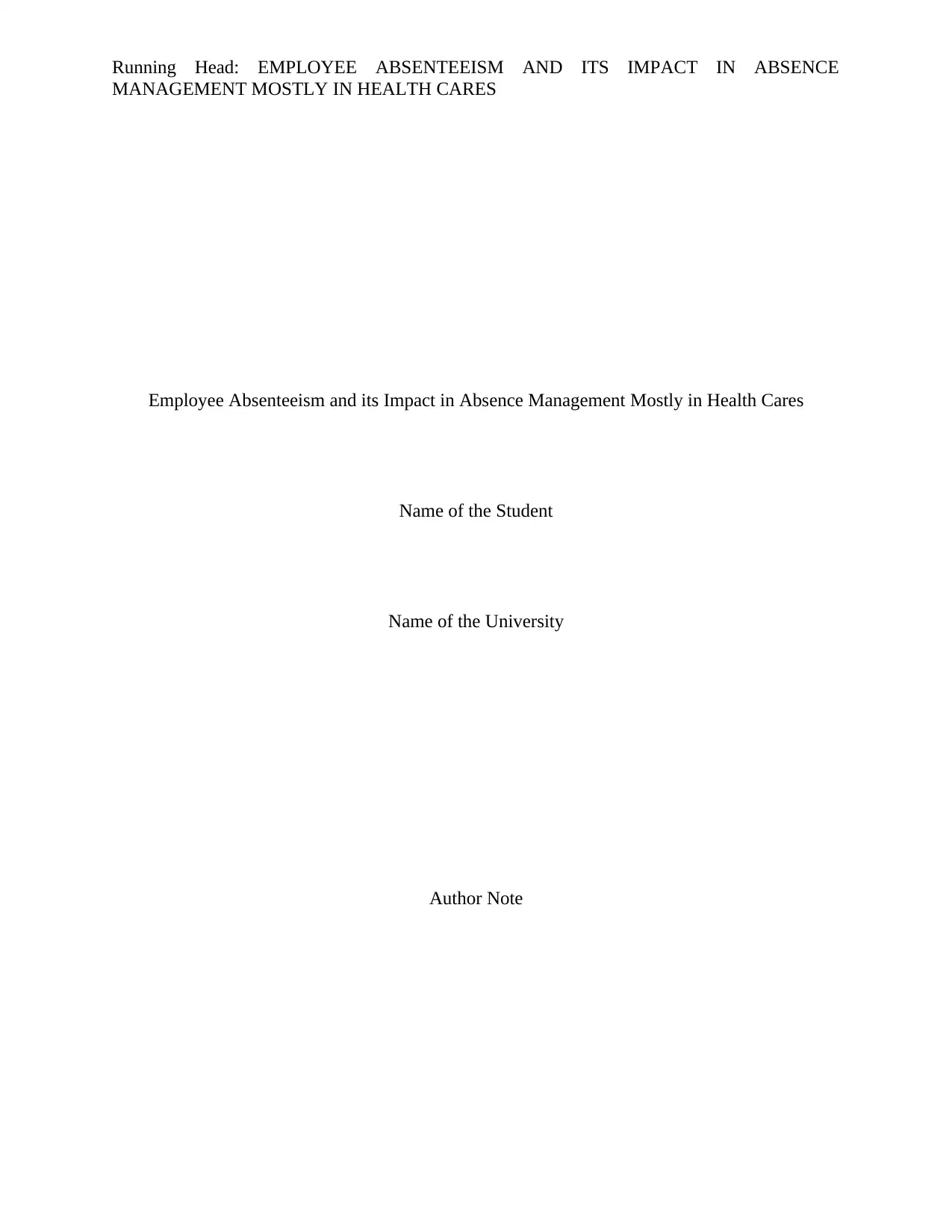
Running Head: EMPLOYEE ABSENTEEISM AND ITS IMPACT IN ABSENCE
MANAGEMENT MOSTLY IN HEALTH CARES
Employee Absenteeism and its Impact in Absence Management Mostly in Health Cares
Name of the Student
Name of the University
Author Note
MANAGEMENT MOSTLY IN HEALTH CARES
Employee Absenteeism and its Impact in Absence Management Mostly in Health Cares
Name of the Student
Name of the University
Author Note
Paraphrase This Document
Need a fresh take? Get an instant paraphrase of this document with our AI Paraphraser
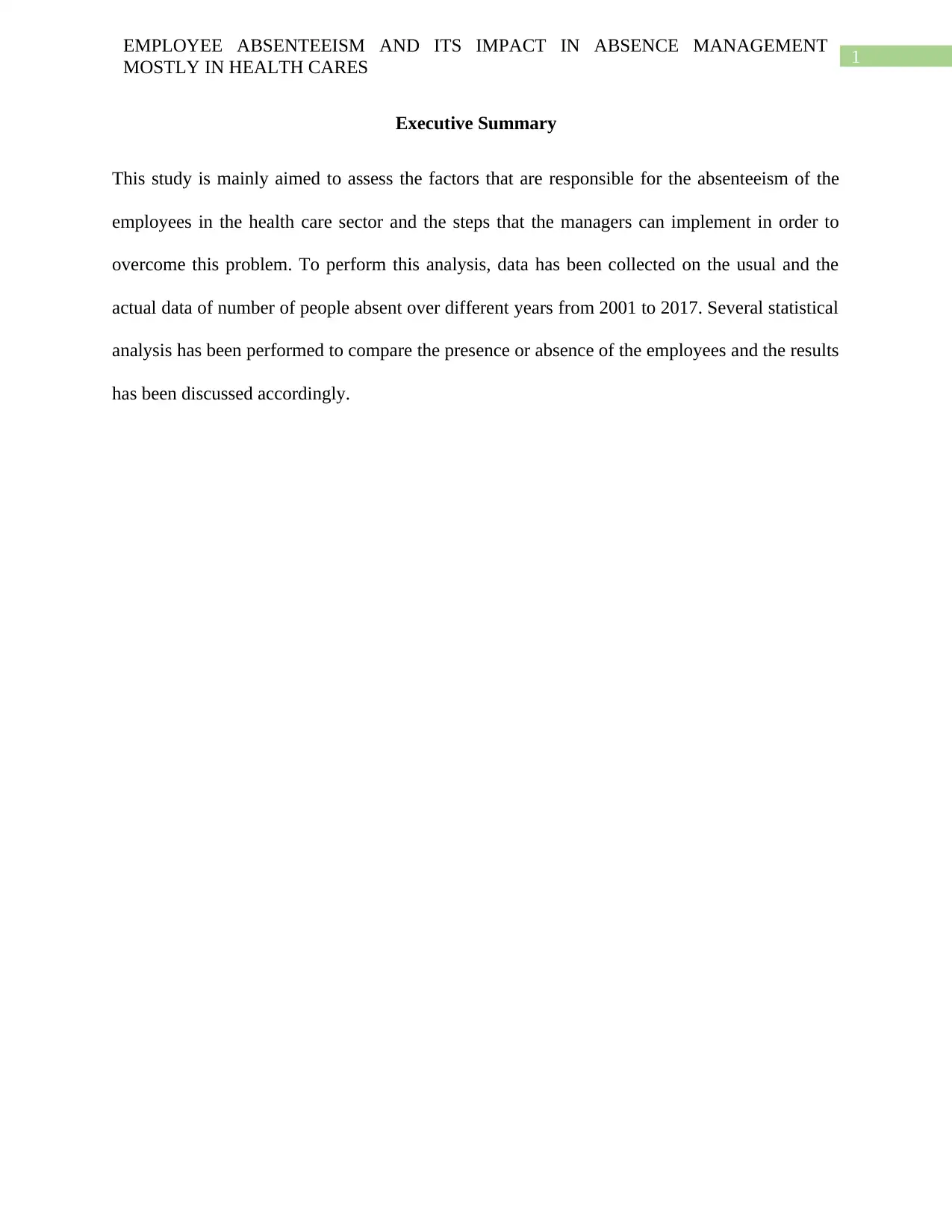
1
EMPLOYEE ABSENTEEISM AND ITS IMPACT IN ABSENCE MANAGEMENT
MOSTLY IN HEALTH CARES
Executive Summary
This study is mainly aimed to assess the factors that are responsible for the absenteeism of the
employees in the health care sector and the steps that the managers can implement in order to
overcome this problem. To perform this analysis, data has been collected on the usual and the
actual data of number of people absent over different years from 2001 to 2017. Several statistical
analysis has been performed to compare the presence or absence of the employees and the results
has been discussed accordingly.
EMPLOYEE ABSENTEEISM AND ITS IMPACT IN ABSENCE MANAGEMENT
MOSTLY IN HEALTH CARES
Executive Summary
This study is mainly aimed to assess the factors that are responsible for the absenteeism of the
employees in the health care sector and the steps that the managers can implement in order to
overcome this problem. To perform this analysis, data has been collected on the usual and the
actual data of number of people absent over different years from 2001 to 2017. Several statistical
analysis has been performed to compare the presence or absence of the employees and the results
has been discussed accordingly.
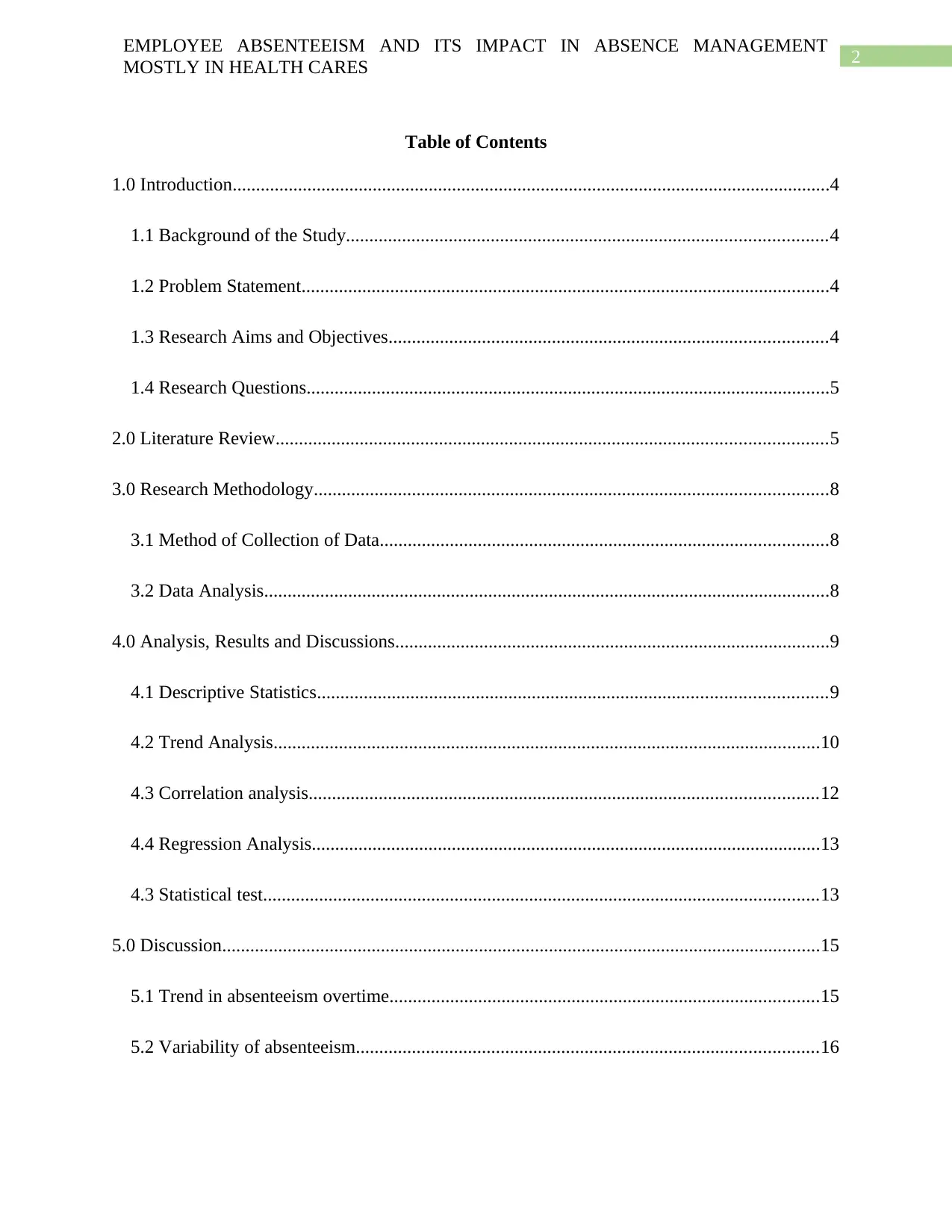
2
EMPLOYEE ABSENTEEISM AND ITS IMPACT IN ABSENCE MANAGEMENT
MOSTLY IN HEALTH CARES
Table of Contents
1.0 Introduction................................................................................................................................4
1.1 Background of the Study.......................................................................................................4
1.2 Problem Statement.................................................................................................................4
1.3 Research Aims and Objectives..............................................................................................4
1.4 Research Questions................................................................................................................5
2.0 Literature Review......................................................................................................................5
3.0 Research Methodology..............................................................................................................8
3.1 Method of Collection of Data................................................................................................8
3.2 Data Analysis.........................................................................................................................8
4.0 Analysis, Results and Discussions.............................................................................................9
4.1 Descriptive Statistics.............................................................................................................9
4.2 Trend Analysis.....................................................................................................................10
4.3 Correlation analysis.............................................................................................................12
4.4 Regression Analysis.............................................................................................................13
4.3 Statistical test.......................................................................................................................13
5.0 Discussion................................................................................................................................15
5.1 Trend in absenteeism overtime............................................................................................15
5.2 Variability of absenteeism...................................................................................................16
EMPLOYEE ABSENTEEISM AND ITS IMPACT IN ABSENCE MANAGEMENT
MOSTLY IN HEALTH CARES
Table of Contents
1.0 Introduction................................................................................................................................4
1.1 Background of the Study.......................................................................................................4
1.2 Problem Statement.................................................................................................................4
1.3 Research Aims and Objectives..............................................................................................4
1.4 Research Questions................................................................................................................5
2.0 Literature Review......................................................................................................................5
3.0 Research Methodology..............................................................................................................8
3.1 Method of Collection of Data................................................................................................8
3.2 Data Analysis.........................................................................................................................8
4.0 Analysis, Results and Discussions.............................................................................................9
4.1 Descriptive Statistics.............................................................................................................9
4.2 Trend Analysis.....................................................................................................................10
4.3 Correlation analysis.............................................................................................................12
4.4 Regression Analysis.............................................................................................................13
4.3 Statistical test.......................................................................................................................13
5.0 Discussion................................................................................................................................15
5.1 Trend in absenteeism overtime............................................................................................15
5.2 Variability of absenteeism...................................................................................................16
⊘ This is a preview!⊘
Do you want full access?
Subscribe today to unlock all pages.

Trusted by 1+ million students worldwide
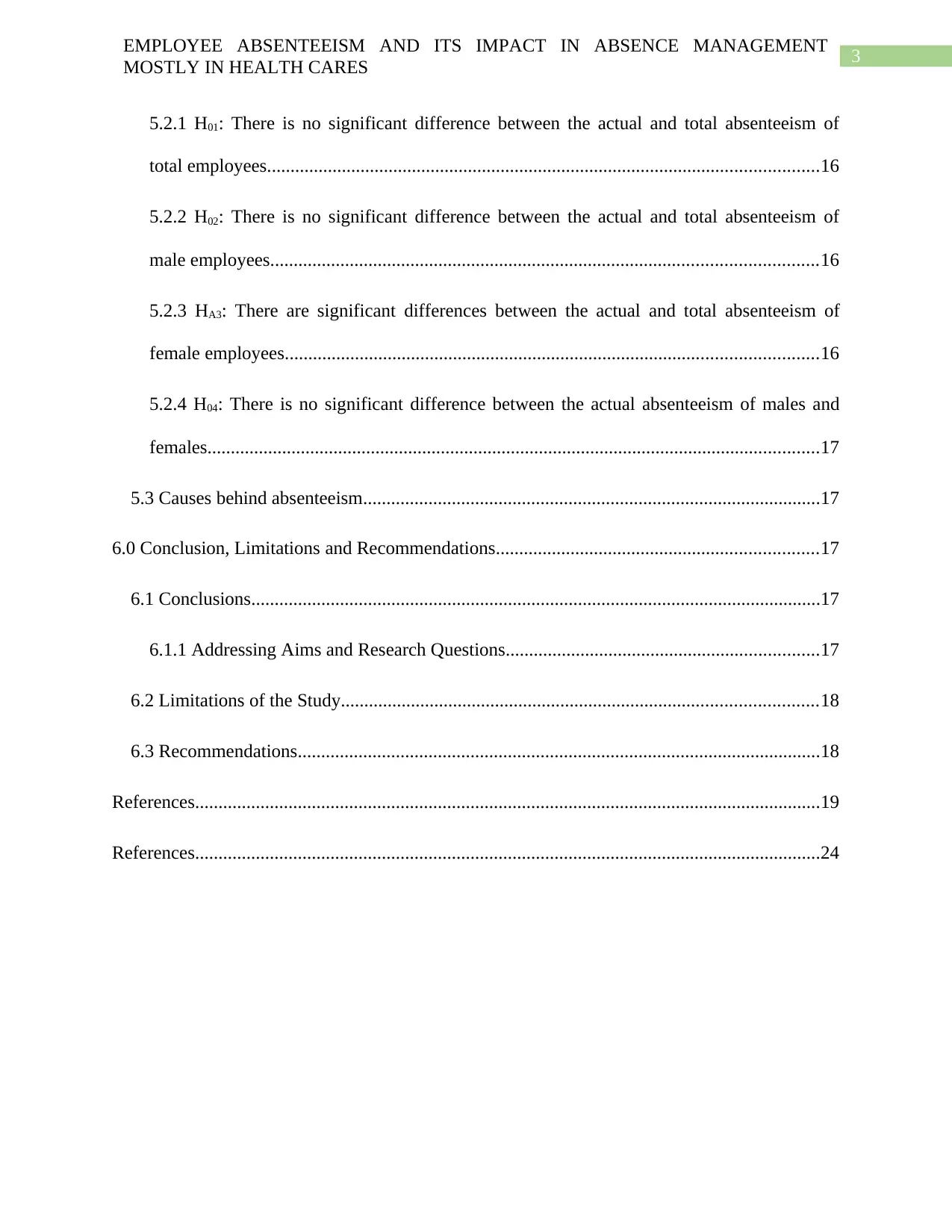
3
EMPLOYEE ABSENTEEISM AND ITS IMPACT IN ABSENCE MANAGEMENT
MOSTLY IN HEALTH CARES
5.2.1 H01: There is no significant difference between the actual and total absenteeism of
total employees......................................................................................................................16
5.2.2 H02: There is no significant difference between the actual and total absenteeism of
male employees.....................................................................................................................16
5.2.3 HA3: There are significant differences between the actual and total absenteeism of
female employees..................................................................................................................16
5.2.4 H04: There is no significant difference between the actual absenteeism of males and
females...................................................................................................................................17
5.3 Causes behind absenteeism..................................................................................................17
6.0 Conclusion, Limitations and Recommendations.....................................................................17
6.1 Conclusions..........................................................................................................................17
6.1.1 Addressing Aims and Research Questions...................................................................17
6.2 Limitations of the Study......................................................................................................18
6.3 Recommendations................................................................................................................18
References......................................................................................................................................19
References......................................................................................................................................24
EMPLOYEE ABSENTEEISM AND ITS IMPACT IN ABSENCE MANAGEMENT
MOSTLY IN HEALTH CARES
5.2.1 H01: There is no significant difference between the actual and total absenteeism of
total employees......................................................................................................................16
5.2.2 H02: There is no significant difference between the actual and total absenteeism of
male employees.....................................................................................................................16
5.2.3 HA3: There are significant differences between the actual and total absenteeism of
female employees..................................................................................................................16
5.2.4 H04: There is no significant difference between the actual absenteeism of males and
females...................................................................................................................................17
5.3 Causes behind absenteeism..................................................................................................17
6.0 Conclusion, Limitations and Recommendations.....................................................................17
6.1 Conclusions..........................................................................................................................17
6.1.1 Addressing Aims and Research Questions...................................................................17
6.2 Limitations of the Study......................................................................................................18
6.3 Recommendations................................................................................................................18
References......................................................................................................................................19
References......................................................................................................................................24
Paraphrase This Document
Need a fresh take? Get an instant paraphrase of this document with our AI Paraphraser
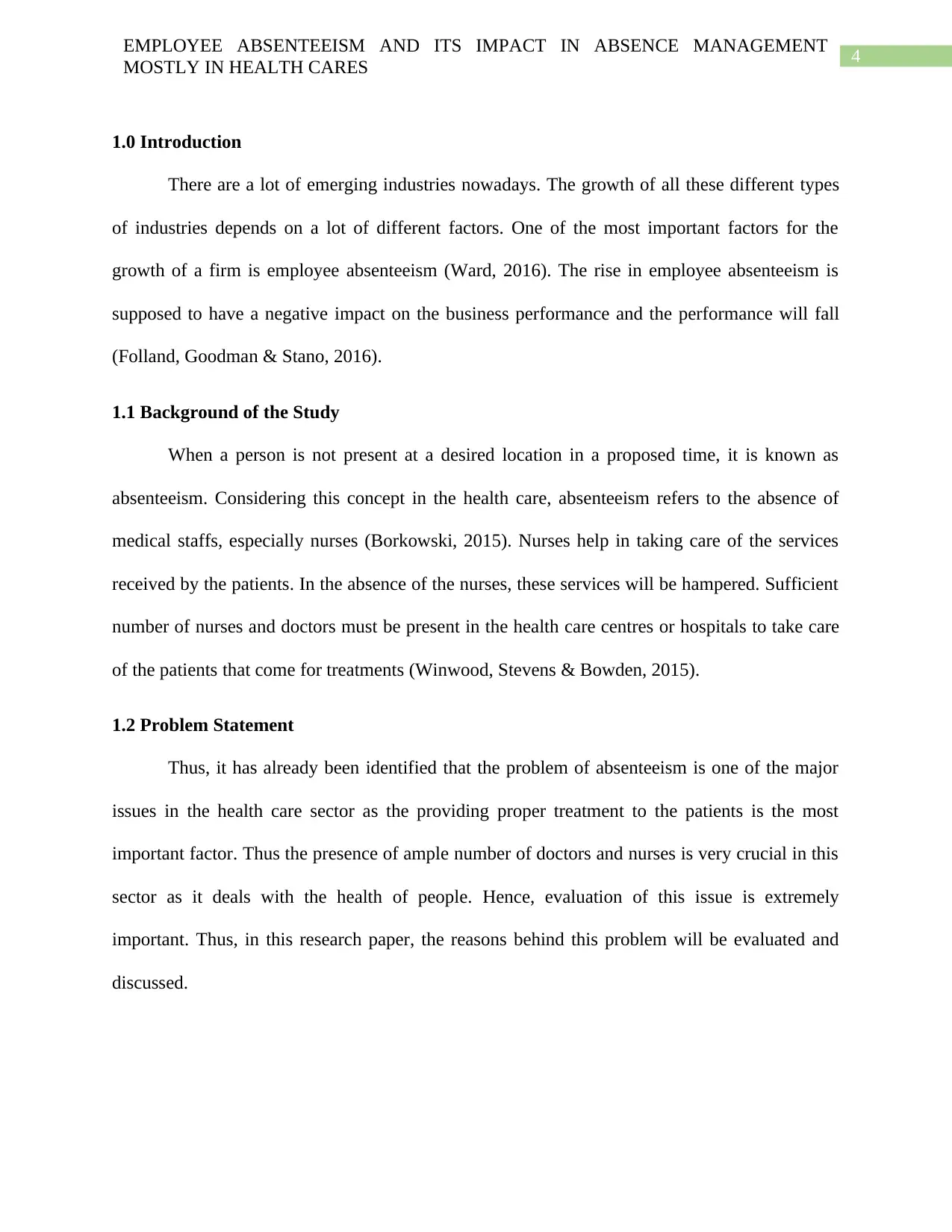
4
EMPLOYEE ABSENTEEISM AND ITS IMPACT IN ABSENCE MANAGEMENT
MOSTLY IN HEALTH CARES
1.0 Introduction
There are a lot of emerging industries nowadays. The growth of all these different types
of industries depends on a lot of different factors. One of the most important factors for the
growth of a firm is employee absenteeism (Ward, 2016). The rise in employee absenteeism is
supposed to have a negative impact on the business performance and the performance will fall
(Folland, Goodman & Stano, 2016).
1.1 Background of the Study
When a person is not present at a desired location in a proposed time, it is known as
absenteeism. Considering this concept in the health care, absenteeism refers to the absence of
medical staffs, especially nurses (Borkowski, 2015). Nurses help in taking care of the services
received by the patients. In the absence of the nurses, these services will be hampered. Sufficient
number of nurses and doctors must be present in the health care centres or hospitals to take care
of the patients that come for treatments (Winwood, Stevens & Bowden, 2015).
1.2 Problem Statement
Thus, it has already been identified that the problem of absenteeism is one of the major
issues in the health care sector as the providing proper treatment to the patients is the most
important factor. Thus the presence of ample number of doctors and nurses is very crucial in this
sector as it deals with the health of people. Hence, evaluation of this issue is extremely
important. Thus, in this research paper, the reasons behind this problem will be evaluated and
discussed.
EMPLOYEE ABSENTEEISM AND ITS IMPACT IN ABSENCE MANAGEMENT
MOSTLY IN HEALTH CARES
1.0 Introduction
There are a lot of emerging industries nowadays. The growth of all these different types
of industries depends on a lot of different factors. One of the most important factors for the
growth of a firm is employee absenteeism (Ward, 2016). The rise in employee absenteeism is
supposed to have a negative impact on the business performance and the performance will fall
(Folland, Goodman & Stano, 2016).
1.1 Background of the Study
When a person is not present at a desired location in a proposed time, it is known as
absenteeism. Considering this concept in the health care, absenteeism refers to the absence of
medical staffs, especially nurses (Borkowski, 2015). Nurses help in taking care of the services
received by the patients. In the absence of the nurses, these services will be hampered. Sufficient
number of nurses and doctors must be present in the health care centres or hospitals to take care
of the patients that come for treatments (Winwood, Stevens & Bowden, 2015).
1.2 Problem Statement
Thus, it has already been identified that the problem of absenteeism is one of the major
issues in the health care sector as the providing proper treatment to the patients is the most
important factor. Thus the presence of ample number of doctors and nurses is very crucial in this
sector as it deals with the health of people. Hence, evaluation of this issue is extremely
important. Thus, in this research paper, the reasons behind this problem will be evaluated and
discussed.
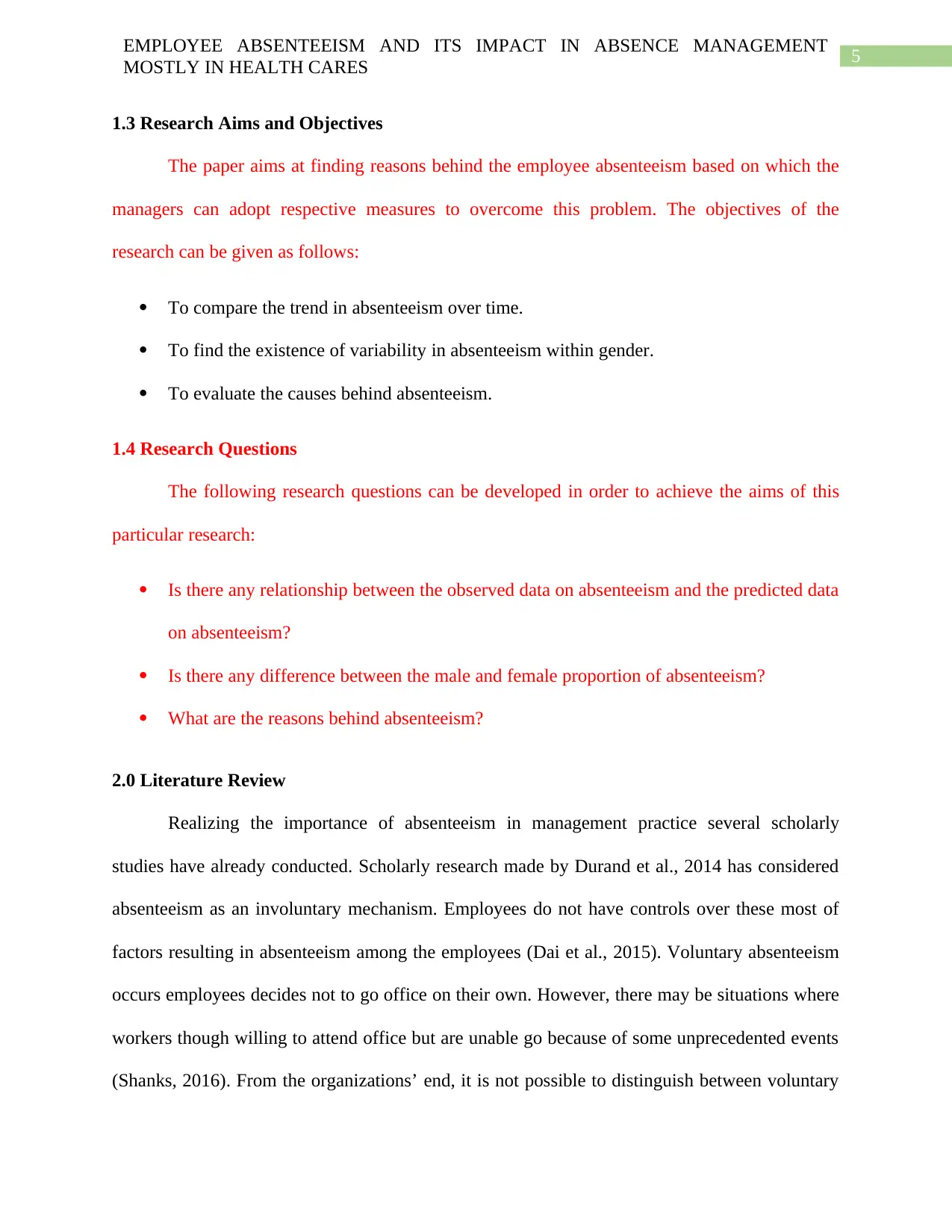
5
EMPLOYEE ABSENTEEISM AND ITS IMPACT IN ABSENCE MANAGEMENT
MOSTLY IN HEALTH CARES
1.3 Research Aims and Objectives
The paper aims at finding reasons behind the employee absenteeism based on which the
managers can adopt respective measures to overcome this problem. The objectives of the
research can be given as follows:
To compare the trend in absenteeism over time.
To find the existence of variability in absenteeism within gender.
To evaluate the causes behind absenteeism.
1.4 Research Questions
The following research questions can be developed in order to achieve the aims of this
particular research:
Is there any relationship between the observed data on absenteeism and the predicted data
on absenteeism?
Is there any difference between the male and female proportion of absenteeism?
What are the reasons behind absenteeism?
2.0 Literature Review
Realizing the importance of absenteeism in management practice several scholarly
studies have already conducted. Scholarly research made by Durand et al., 2014 has considered
absenteeism as an involuntary mechanism. Employees do not have controls over these most of
factors resulting in absenteeism among the employees (Dai et al., 2015). Voluntary absenteeism
occurs employees decides not to go office on their own. However, there may be situations where
workers though willing to attend office but are unable go because of some unprecedented events
(Shanks, 2016). From the organizations’ end, it is not possible to distinguish between voluntary
EMPLOYEE ABSENTEEISM AND ITS IMPACT IN ABSENCE MANAGEMENT
MOSTLY IN HEALTH CARES
1.3 Research Aims and Objectives
The paper aims at finding reasons behind the employee absenteeism based on which the
managers can adopt respective measures to overcome this problem. The objectives of the
research can be given as follows:
To compare the trend in absenteeism over time.
To find the existence of variability in absenteeism within gender.
To evaluate the causes behind absenteeism.
1.4 Research Questions
The following research questions can be developed in order to achieve the aims of this
particular research:
Is there any relationship between the observed data on absenteeism and the predicted data
on absenteeism?
Is there any difference between the male and female proportion of absenteeism?
What are the reasons behind absenteeism?
2.0 Literature Review
Realizing the importance of absenteeism in management practice several scholarly
studies have already conducted. Scholarly research made by Durand et al., 2014 has considered
absenteeism as an involuntary mechanism. Employees do not have controls over these most of
factors resulting in absenteeism among the employees (Dai et al., 2015). Voluntary absenteeism
occurs employees decides not to go office on their own. However, there may be situations where
workers though willing to attend office but are unable go because of some unprecedented events
(Shanks, 2016). From the organizations’ end, it is not possible to distinguish between voluntary
⊘ This is a preview!⊘
Do you want full access?
Subscribe today to unlock all pages.

Trusted by 1+ million students worldwide
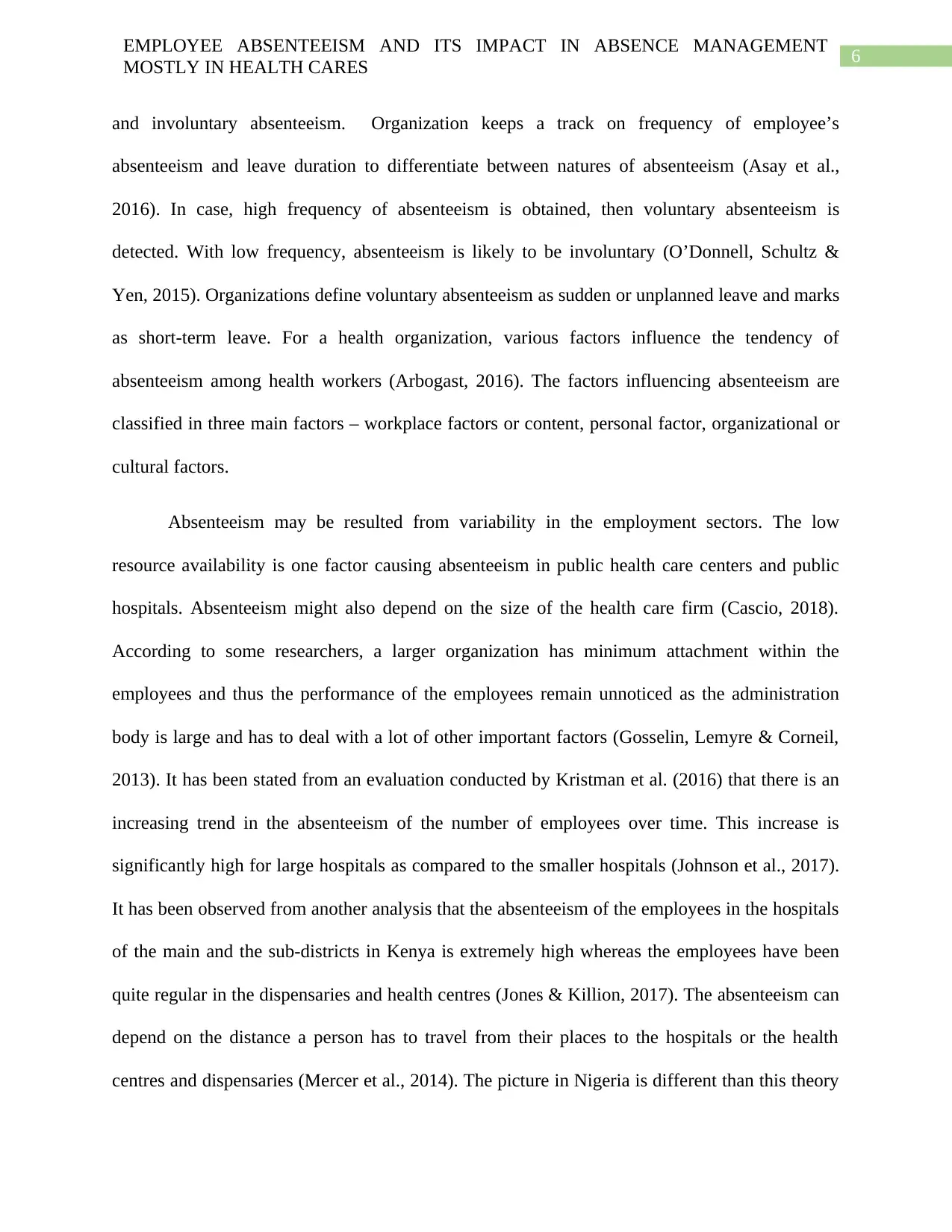
6
EMPLOYEE ABSENTEEISM AND ITS IMPACT IN ABSENCE MANAGEMENT
MOSTLY IN HEALTH CARES
and involuntary absenteeism. Organization keeps a track on frequency of employee’s
absenteeism and leave duration to differentiate between natures of absenteeism (Asay et al.,
2016). In case, high frequency of absenteeism is obtained, then voluntary absenteeism is
detected. With low frequency, absenteeism is likely to be involuntary (O’Donnell, Schultz &
Yen, 2015). Organizations define voluntary absenteeism as sudden or unplanned leave and marks
as short-term leave. For a health organization, various factors influence the tendency of
absenteeism among health workers (Arbogast, 2016). The factors influencing absenteeism are
classified in three main factors – workplace factors or content, personal factor, organizational or
cultural factors.
Absenteeism may be resulted from variability in the employment sectors. The low
resource availability is one factor causing absenteeism in public health care centers and public
hospitals. Absenteeism might also depend on the size of the health care firm (Cascio, 2018).
According to some researchers, a larger organization has minimum attachment within the
employees and thus the performance of the employees remain unnoticed as the administration
body is large and has to deal with a lot of other important factors (Gosselin, Lemyre & Corneil,
2013). It has been stated from an evaluation conducted by Kristman et al. (2016) that there is an
increasing trend in the absenteeism of the number of employees over time. This increase is
significantly high for large hospitals as compared to the smaller hospitals (Johnson et al., 2017).
It has been observed from another analysis that the absenteeism of the employees in the hospitals
of the main and the sub-districts in Kenya is extremely high whereas the employees have been
quite regular in the dispensaries and health centres (Jones & Killion, 2017). The absenteeism can
depend on the distance a person has to travel from their places to the hospitals or the health
centres and dispensaries (Mercer et al., 2014). The picture in Nigeria is different than this theory
EMPLOYEE ABSENTEEISM AND ITS IMPACT IN ABSENCE MANAGEMENT
MOSTLY IN HEALTH CARES
and involuntary absenteeism. Organization keeps a track on frequency of employee’s
absenteeism and leave duration to differentiate between natures of absenteeism (Asay et al.,
2016). In case, high frequency of absenteeism is obtained, then voluntary absenteeism is
detected. With low frequency, absenteeism is likely to be involuntary (O’Donnell, Schultz &
Yen, 2015). Organizations define voluntary absenteeism as sudden or unplanned leave and marks
as short-term leave. For a health organization, various factors influence the tendency of
absenteeism among health workers (Arbogast, 2016). The factors influencing absenteeism are
classified in three main factors – workplace factors or content, personal factor, organizational or
cultural factors.
Absenteeism may be resulted from variability in the employment sectors. The low
resource availability is one factor causing absenteeism in public health care centers and public
hospitals. Absenteeism might also depend on the size of the health care firm (Cascio, 2018).
According to some researchers, a larger organization has minimum attachment within the
employees and thus the performance of the employees remain unnoticed as the administration
body is large and has to deal with a lot of other important factors (Gosselin, Lemyre & Corneil,
2013). It has been stated from an evaluation conducted by Kristman et al. (2016) that there is an
increasing trend in the absenteeism of the number of employees over time. This increase is
significantly high for large hospitals as compared to the smaller hospitals (Johnson et al., 2017).
It has been observed from another analysis that the absenteeism of the employees in the hospitals
of the main and the sub-districts in Kenya is extremely high whereas the employees have been
quite regular in the dispensaries and health centres (Jones & Killion, 2017). The absenteeism can
depend on the distance a person has to travel from their places to the hospitals or the health
centres and dispensaries (Mercer et al., 2014). The picture in Nigeria is different than this theory
Paraphrase This Document
Need a fresh take? Get an instant paraphrase of this document with our AI Paraphraser
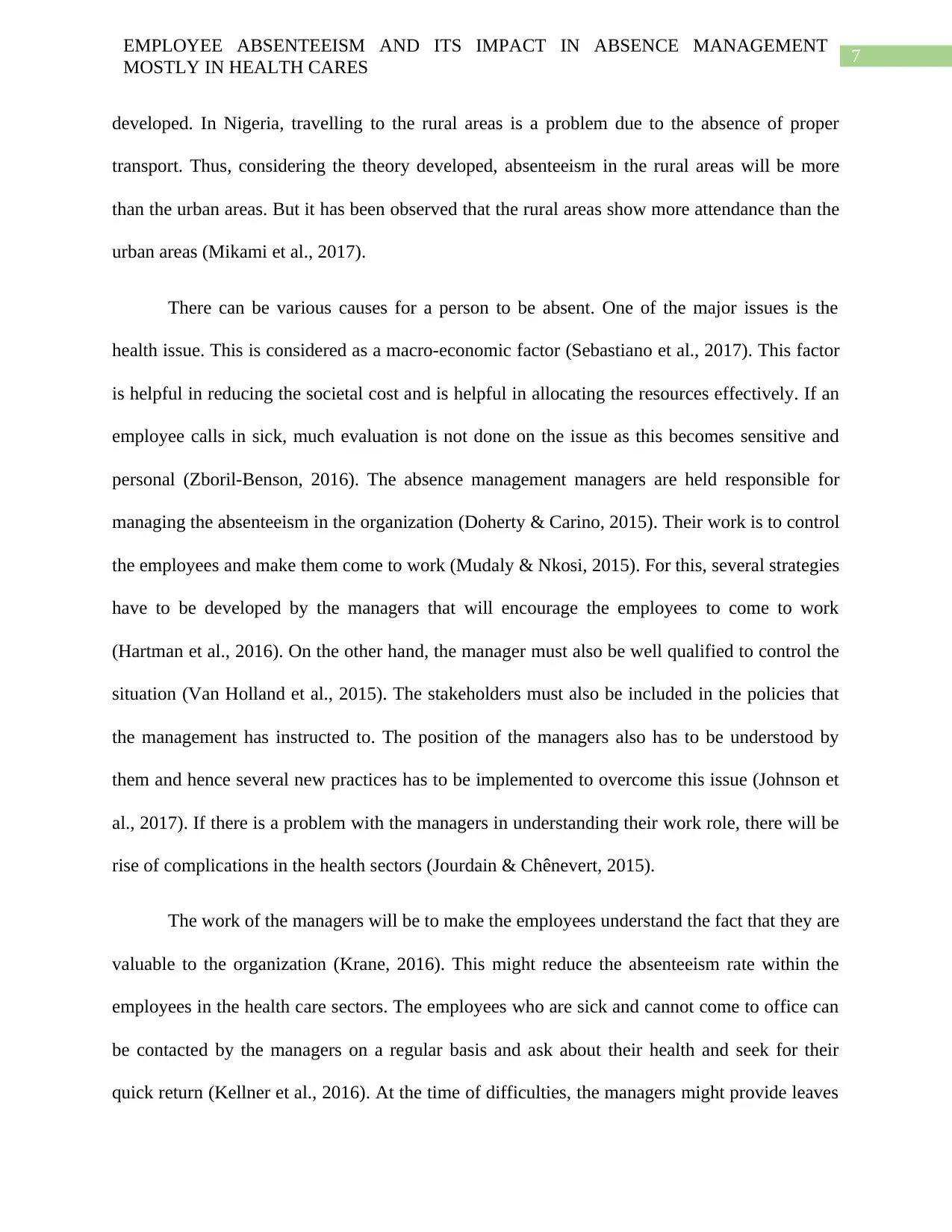
7
EMPLOYEE ABSENTEEISM AND ITS IMPACT IN ABSENCE MANAGEMENT
MOSTLY IN HEALTH CARES
developed. In Nigeria, travelling to the rural areas is a problem due to the absence of proper
transport. Thus, considering the theory developed, absenteeism in the rural areas will be more
than the urban areas. But it has been observed that the rural areas show more attendance than the
urban areas (Mikami et al., 2017).
There can be various causes for a person to be absent. One of the major issues is the
health issue. This is considered as a macro-economic factor (Sebastiano et al., 2017). This factor
is helpful in reducing the societal cost and is helpful in allocating the resources effectively. If an
employee calls in sick, much evaluation is not done on the issue as this becomes sensitive and
personal (Zboril-Benson, 2016). The absence management managers are held responsible for
managing the absenteeism in the organization (Doherty & Carino, 2015). Their work is to control
the employees and make them come to work (Mudaly & Nkosi, 2015). For this, several strategies
have to be developed by the managers that will encourage the employees to come to work
(Hartman et al., 2016). On the other hand, the manager must also be well qualified to control the
situation (Van Holland et al., 2015). The stakeholders must also be included in the policies that
the management has instructed to. The position of the managers also has to be understood by
them and hence several new practices has to be implemented to overcome this issue (Johnson et
al., 2017). If there is a problem with the managers in understanding their work role, there will be
rise of complications in the health sectors (Jourdain & Chênevert, 2015).
The work of the managers will be to make the employees understand the fact that they are
valuable to the organization (Krane, 2016). This might reduce the absenteeism rate within the
employees in the health care sectors. The employees who are sick and cannot come to office can
be contacted by the managers on a regular basis and ask about their health and seek for their
quick return (Kellner et al., 2016). At the time of difficulties, the managers might provide leaves
EMPLOYEE ABSENTEEISM AND ITS IMPACT IN ABSENCE MANAGEMENT
MOSTLY IN HEALTH CARES
developed. In Nigeria, travelling to the rural areas is a problem due to the absence of proper
transport. Thus, considering the theory developed, absenteeism in the rural areas will be more
than the urban areas. But it has been observed that the rural areas show more attendance than the
urban areas (Mikami et al., 2017).
There can be various causes for a person to be absent. One of the major issues is the
health issue. This is considered as a macro-economic factor (Sebastiano et al., 2017). This factor
is helpful in reducing the societal cost and is helpful in allocating the resources effectively. If an
employee calls in sick, much evaluation is not done on the issue as this becomes sensitive and
personal (Zboril-Benson, 2016). The absence management managers are held responsible for
managing the absenteeism in the organization (Doherty & Carino, 2015). Their work is to control
the employees and make them come to work (Mudaly & Nkosi, 2015). For this, several strategies
have to be developed by the managers that will encourage the employees to come to work
(Hartman et al., 2016). On the other hand, the manager must also be well qualified to control the
situation (Van Holland et al., 2015). The stakeholders must also be included in the policies that
the management has instructed to. The position of the managers also has to be understood by
them and hence several new practices has to be implemented to overcome this issue (Johnson et
al., 2017). If there is a problem with the managers in understanding their work role, there will be
rise of complications in the health sectors (Jourdain & Chênevert, 2015).
The work of the managers will be to make the employees understand the fact that they are
valuable to the organization (Krane, 2016). This might reduce the absenteeism rate within the
employees in the health care sectors. The employees who are sick and cannot come to office can
be contacted by the managers on a regular basis and ask about their health and seek for their
quick return (Kellner et al., 2016). At the time of difficulties, the managers might provide leaves
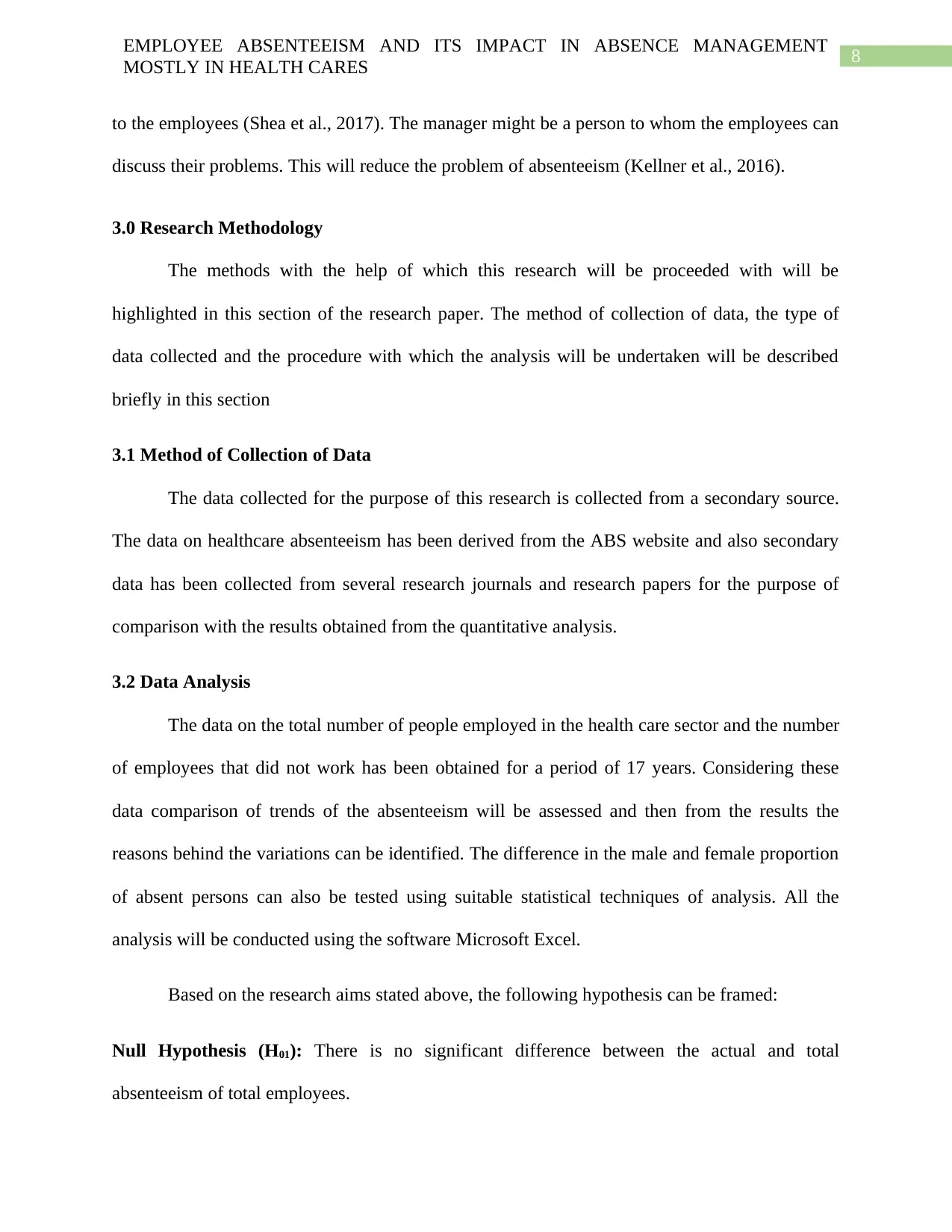
8
EMPLOYEE ABSENTEEISM AND ITS IMPACT IN ABSENCE MANAGEMENT
MOSTLY IN HEALTH CARES
to the employees (Shea et al., 2017). The manager might be a person to whom the employees can
discuss their problems. This will reduce the problem of absenteeism (Kellner et al., 2016).
3.0 Research Methodology
The methods with the help of which this research will be proceeded with will be
highlighted in this section of the research paper. The method of collection of data, the type of
data collected and the procedure with which the analysis will be undertaken will be described
briefly in this section
3.1 Method of Collection of Data
The data collected for the purpose of this research is collected from a secondary source.
The data on healthcare absenteeism has been derived from the ABS website and also secondary
data has been collected from several research journals and research papers for the purpose of
comparison with the results obtained from the quantitative analysis.
3.2 Data Analysis
The data on the total number of people employed in the health care sector and the number
of employees that did not work has been obtained for a period of 17 years. Considering these
data comparison of trends of the absenteeism will be assessed and then from the results the
reasons behind the variations can be identified. The difference in the male and female proportion
of absent persons can also be tested using suitable statistical techniques of analysis. All the
analysis will be conducted using the software Microsoft Excel.
Based on the research aims stated above, the following hypothesis can be framed:
Null Hypothesis (H01): There is no significant difference between the actual and total
absenteeism of total employees.
EMPLOYEE ABSENTEEISM AND ITS IMPACT IN ABSENCE MANAGEMENT
MOSTLY IN HEALTH CARES
to the employees (Shea et al., 2017). The manager might be a person to whom the employees can
discuss their problems. This will reduce the problem of absenteeism (Kellner et al., 2016).
3.0 Research Methodology
The methods with the help of which this research will be proceeded with will be
highlighted in this section of the research paper. The method of collection of data, the type of
data collected and the procedure with which the analysis will be undertaken will be described
briefly in this section
3.1 Method of Collection of Data
The data collected for the purpose of this research is collected from a secondary source.
The data on healthcare absenteeism has been derived from the ABS website and also secondary
data has been collected from several research journals and research papers for the purpose of
comparison with the results obtained from the quantitative analysis.
3.2 Data Analysis
The data on the total number of people employed in the health care sector and the number
of employees that did not work has been obtained for a period of 17 years. Considering these
data comparison of trends of the absenteeism will be assessed and then from the results the
reasons behind the variations can be identified. The difference in the male and female proportion
of absent persons can also be tested using suitable statistical techniques of analysis. All the
analysis will be conducted using the software Microsoft Excel.
Based on the research aims stated above, the following hypothesis can be framed:
Null Hypothesis (H01): There is no significant difference between the actual and total
absenteeism of total employees.
⊘ This is a preview!⊘
Do you want full access?
Subscribe today to unlock all pages.

Trusted by 1+ million students worldwide
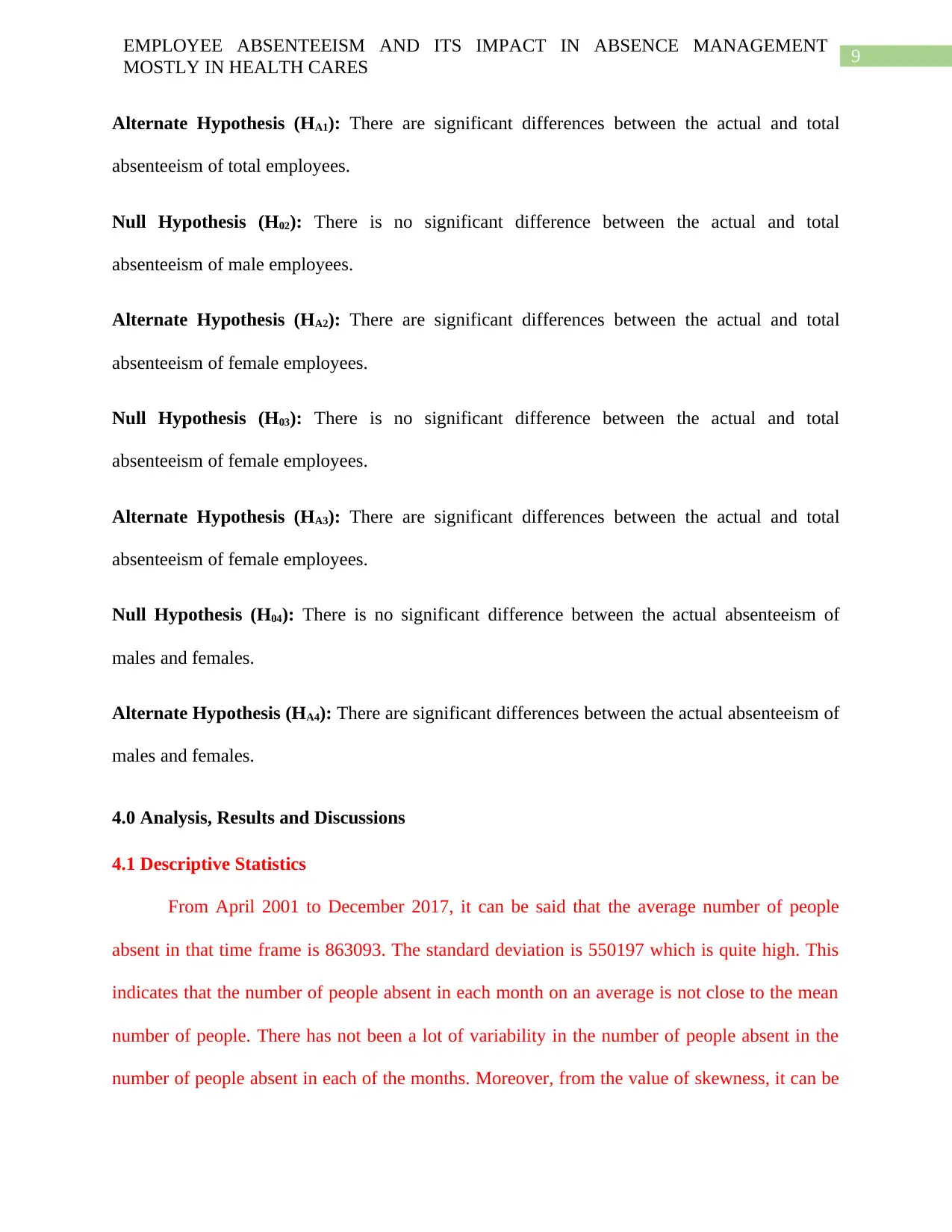
9
EMPLOYEE ABSENTEEISM AND ITS IMPACT IN ABSENCE MANAGEMENT
MOSTLY IN HEALTH CARES
Alternate Hypothesis (HA1): There are significant differences between the actual and total
absenteeism of total employees.
Null Hypothesis (H02): There is no significant difference between the actual and total
absenteeism of male employees.
Alternate Hypothesis (HA2): There are significant differences between the actual and total
absenteeism of female employees.
Null Hypothesis (H03): There is no significant difference between the actual and total
absenteeism of female employees.
Alternate Hypothesis (HA3): There are significant differences between the actual and total
absenteeism of female employees.
Null Hypothesis (H04): There is no significant difference between the actual absenteeism of
males and females.
Alternate Hypothesis (HA4): There are significant differences between the actual absenteeism of
males and females.
4.0 Analysis, Results and Discussions
4.1 Descriptive Statistics
From April 2001 to December 2017, it can be said that the average number of people
absent in that time frame is 863093. The standard deviation is 550197 which is quite high. This
indicates that the number of people absent in each month on an average is not close to the mean
number of people. There has not been a lot of variability in the number of people absent in the
number of people absent in each of the months. Moreover, from the value of skewness, it can be
EMPLOYEE ABSENTEEISM AND ITS IMPACT IN ABSENCE MANAGEMENT
MOSTLY IN HEALTH CARES
Alternate Hypothesis (HA1): There are significant differences between the actual and total
absenteeism of total employees.
Null Hypothesis (H02): There is no significant difference between the actual and total
absenteeism of male employees.
Alternate Hypothesis (HA2): There are significant differences between the actual and total
absenteeism of female employees.
Null Hypothesis (H03): There is no significant difference between the actual and total
absenteeism of female employees.
Alternate Hypothesis (HA3): There are significant differences between the actual and total
absenteeism of female employees.
Null Hypothesis (H04): There is no significant difference between the actual absenteeism of
males and females.
Alternate Hypothesis (HA4): There are significant differences between the actual absenteeism of
males and females.
4.0 Analysis, Results and Discussions
4.1 Descriptive Statistics
From April 2001 to December 2017, it can be said that the average number of people
absent in that time frame is 863093. The standard deviation is 550197 which is quite high. This
indicates that the number of people absent in each month on an average is not close to the mean
number of people. There has not been a lot of variability in the number of people absent in the
number of people absent in each of the months. Moreover, from the value of skewness, it can be
Paraphrase This Document
Need a fresh take? Get an instant paraphrase of this document with our AI Paraphraser
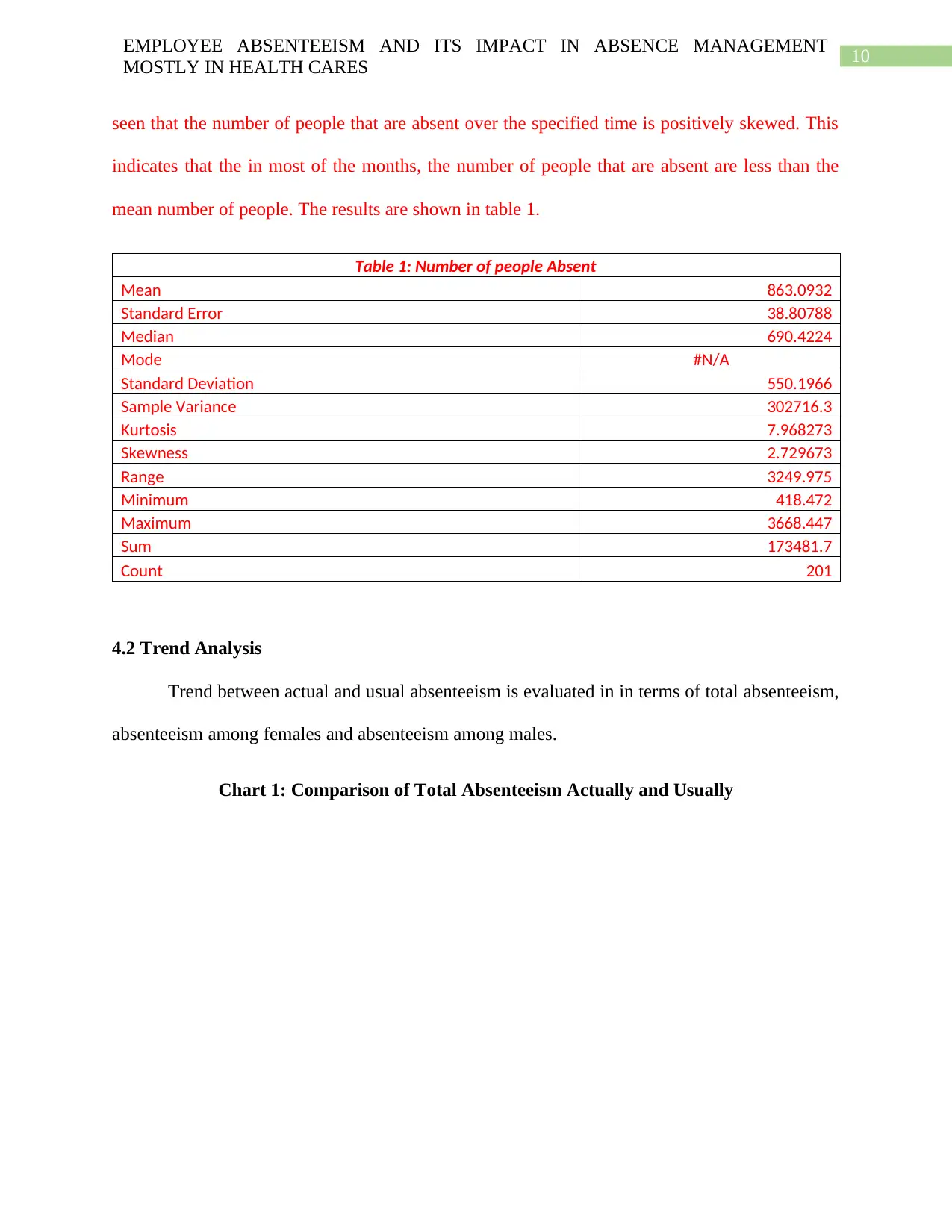
10
EMPLOYEE ABSENTEEISM AND ITS IMPACT IN ABSENCE MANAGEMENT
MOSTLY IN HEALTH CARES
seen that the number of people that are absent over the specified time is positively skewed. This
indicates that the in most of the months, the number of people that are absent are less than the
mean number of people. The results are shown in table 1.
Table 1: Number of people Absent
Mean 863.0932
Standard Error 38.80788
Median 690.4224
Mode #N/A
Standard Deviation 550.1966
Sample Variance 302716.3
Kurtosis 7.968273
Skewness 2.729673
Range 3249.975
Minimum 418.472
Maximum 3668.447
Sum 173481.7
Count 201
4.2 Trend Analysis
Trend between actual and usual absenteeism is evaluated in in terms of total absenteeism,
absenteeism among females and absenteeism among males.
Chart 1: Comparison of Total Absenteeism Actually and Usually
EMPLOYEE ABSENTEEISM AND ITS IMPACT IN ABSENCE MANAGEMENT
MOSTLY IN HEALTH CARES
seen that the number of people that are absent over the specified time is positively skewed. This
indicates that the in most of the months, the number of people that are absent are less than the
mean number of people. The results are shown in table 1.
Table 1: Number of people Absent
Mean 863.0932
Standard Error 38.80788
Median 690.4224
Mode #N/A
Standard Deviation 550.1966
Sample Variance 302716.3
Kurtosis 7.968273
Skewness 2.729673
Range 3249.975
Minimum 418.472
Maximum 3668.447
Sum 173481.7
Count 201
4.2 Trend Analysis
Trend between actual and usual absenteeism is evaluated in in terms of total absenteeism,
absenteeism among females and absenteeism among males.
Chart 1: Comparison of Total Absenteeism Actually and Usually
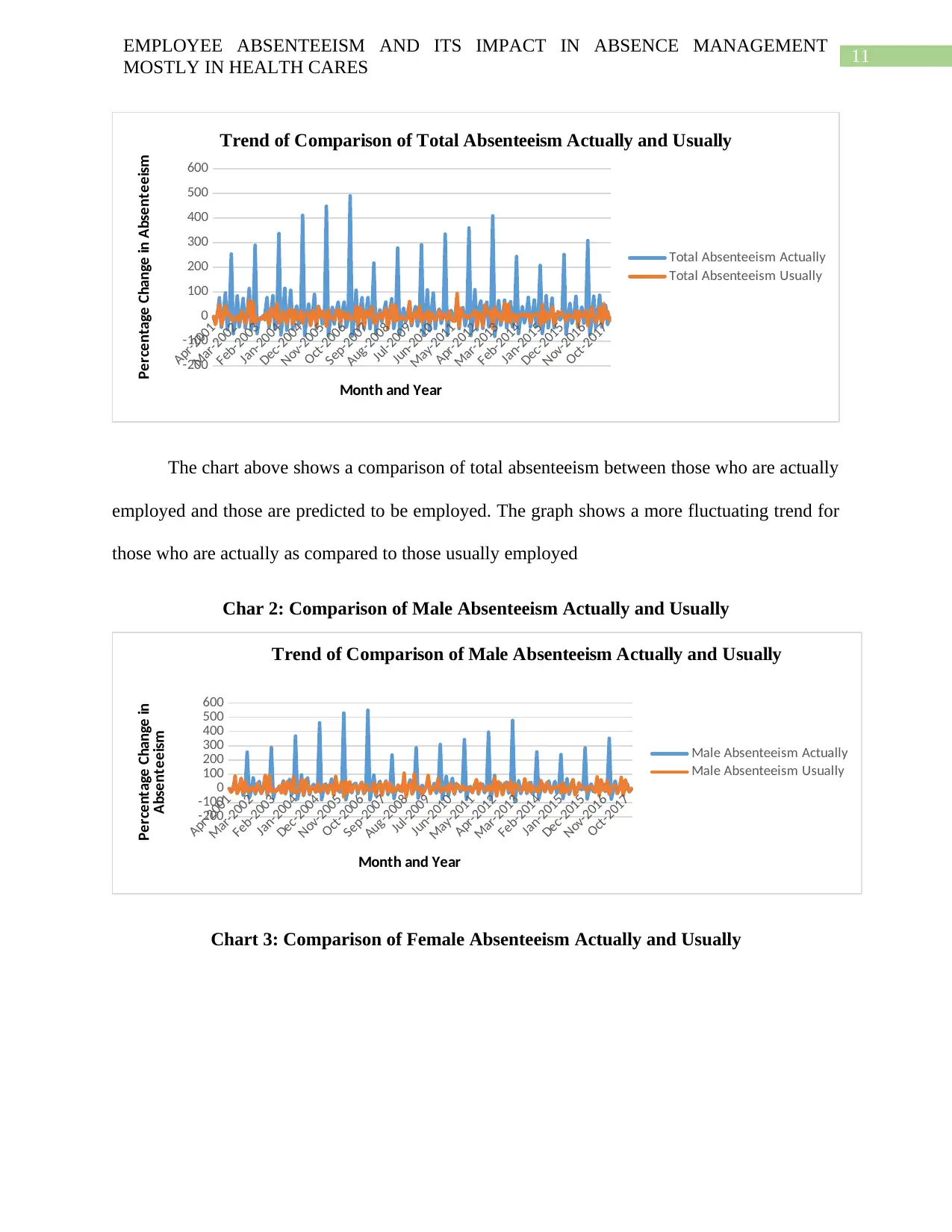
11
EMPLOYEE ABSENTEEISM AND ITS IMPACT IN ABSENCE MANAGEMENT
MOSTLY IN HEALTH CARES
Apr-2001
Mar-2002
Feb-2003
Jan-2004
Dec-2004
Nov-2005
Oct-2006
Sep-2007
Aug-2008
Jul-2009
Jun-2010
May-2011
Apr-2012
Mar-2013
Feb-2014
Jan-2015
Dec-2015
Nov-2016
Oct-2017
-200
-100
0
100
200
300
400
500
600
Trend of Comparison of Total Absenteeism Actually and Usually
Total Absenteeism Actually
Total Absenteeism Usually
Month and Year
Percentage Change in Absenteeism
The chart above shows a comparison of total absenteeism between those who are actually
employed and those are predicted to be employed. The graph shows a more fluctuating trend for
those who are actually as compared to those usually employed
Char 2: Comparison of Male Absenteeism Actually and Usually
Apr-2001
Mar-2002
Feb-2003
Jan-2004
Dec-2004
Nov-2005
Oct-2006
Sep-2007
Aug-2008
Jul-2009
Jun-2010
May-2011
Apr-2012
Mar-2013
Feb-2014
Jan-2015
Dec-2015
Nov-2016
Oct-2017
-200
-100
0
100
200
300
400
500
600
Trend of Comparison of Male Absenteeism Actually and Usually
Male Absenteeism Actually
Male Absenteeism Usually
Month and Year
Percentage Change in
Absenteeism
Chart 3: Comparison of Female Absenteeism Actually and Usually
EMPLOYEE ABSENTEEISM AND ITS IMPACT IN ABSENCE MANAGEMENT
MOSTLY IN HEALTH CARES
Apr-2001
Mar-2002
Feb-2003
Jan-2004
Dec-2004
Nov-2005
Oct-2006
Sep-2007
Aug-2008
Jul-2009
Jun-2010
May-2011
Apr-2012
Mar-2013
Feb-2014
Jan-2015
Dec-2015
Nov-2016
Oct-2017
-200
-100
0
100
200
300
400
500
600
Trend of Comparison of Total Absenteeism Actually and Usually
Total Absenteeism Actually
Total Absenteeism Usually
Month and Year
Percentage Change in Absenteeism
The chart above shows a comparison of total absenteeism between those who are actually
employed and those are predicted to be employed. The graph shows a more fluctuating trend for
those who are actually as compared to those usually employed
Char 2: Comparison of Male Absenteeism Actually and Usually
Apr-2001
Mar-2002
Feb-2003
Jan-2004
Dec-2004
Nov-2005
Oct-2006
Sep-2007
Aug-2008
Jul-2009
Jun-2010
May-2011
Apr-2012
Mar-2013
Feb-2014
Jan-2015
Dec-2015
Nov-2016
Oct-2017
-200
-100
0
100
200
300
400
500
600
Trend of Comparison of Male Absenteeism Actually and Usually
Male Absenteeism Actually
Male Absenteeism Usually
Month and Year
Percentage Change in
Absenteeism
Chart 3: Comparison of Female Absenteeism Actually and Usually
⊘ This is a preview!⊘
Do you want full access?
Subscribe today to unlock all pages.

Trusted by 1+ million students worldwide
1 out of 26
Related Documents
Your All-in-One AI-Powered Toolkit for Academic Success.
+13062052269
info@desklib.com
Available 24*7 on WhatsApp / Email
![[object Object]](/_next/static/media/star-bottom.7253800d.svg)
Unlock your academic potential
Copyright © 2020–2025 A2Z Services. All Rights Reserved. Developed and managed by ZUCOL.





